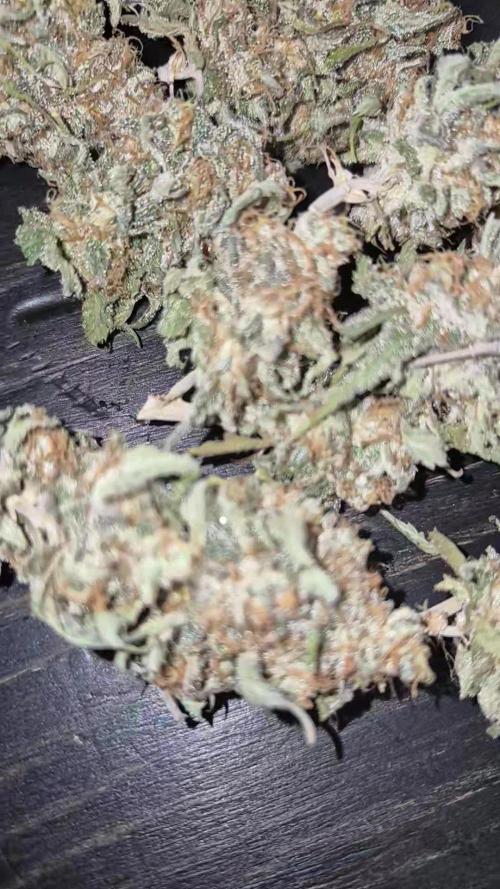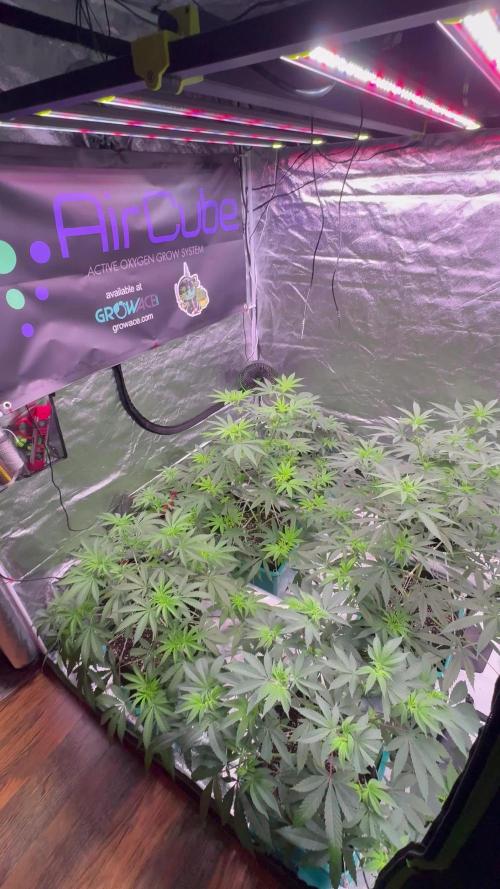The Grow Awards 2026 🏆 





































Likes
Comments
Share


@sunshinegroww
Follow
Shes just growing and growing biggest of all so far looking nice and heal
Likes
12
Share


@Chubbs
Follow
420FASTBUDS
ORT2108 WEEK 8
I've enjoyed seeing these grow as the weekly updates are very noticeable. I decided to do some LST training and it seems to have made an improvement. I also backed off the nutes with only leaving the calmag and ph the water before watering. All in all Happy Growing.
Likes
16
Share


@Mospeada
Follow
End of week 4, beginning of week 5. This will be my second complete grow in a RDWC system. I have just over 18 months experience in growing. For the first year I had a few plants that I grew whilst doing my homework. I'm still applying my learning's but I think the pictures are enough for me to claim I've done pretty well completely on my own. Still undecided in defoliating but that top shot I have is a pretty damning photo. My idea is to let the plant choose by removing sicker leaves in there that I can pull off easily or feel damp and soft from humidity. In saying that...it's been healthy all through atm. I think the lights below really help in keeping the humidity down a little and also negating the shade response from how thick it is. Anyway, still experimenting, lots to learn.
Likes
17
Share


@ILoVeThiSpLaNt
Follow
Ultimi giorni per una pianta mentre altre due sono a seccare. Qua foto e video delle prime tre piante tolte. A settimana prossima 😊
Processing
Likes
16
Share


@Andres
Follow
I still have to wait for about 8 weeks, I believe in the open air ... they already have a smell of fruit and forest ... with one of them has nutrients from the biobizz tripack ... because it had a lack of nutrients ... a measure 40 cm and the ptra is around 1.70 ... waiting for the fattening of buds
Likes
7
Share


@Lucidgrower09
Follow
They have been transplanted in 15l pots aswell as the rainbow candys. We will see how they recover. Its 50/50 plagron growmix and batmix.
Processing
Likes
7
Share


@Kushizlez
Follow
(Days 15-21)
(Day 21) Everything is looking really good this week. I got my MH hooked up and dimmed to 250w. Plants are responding very well. Not a single sign of yellowing and plants are all a nice healthy green. I covered up the transparent solo cups with some newspaper as the roots are starting to pool around the bottom of the cups. I’m going to transplant everything into 2gal pots with my inoculated 50/50 coco blend sometime next week. There is a nice layer of mycorrhizal fungi starting to coat the surface now.
Blackberry breath #1 is still looking oddly deformed still but I am concluding it’s genetic.
Going to be trying this ‘Boogie Brew’ tea stuff in the next few days as well.
I’m pretty sure the leaf discoloring I saw that one day was from using unstable RO water. I am making sure to stabilize all water with rain/snow/brita before watering. It seems to have cleared up in a just a few days of proper water.
I didn’t get around to getting a c02 canister this week but I will grab it at the same time I get those 2gal nursery pots.
I’m shocked at how well the air pump is helping the bbb#2. It is always the perkiest plant in the tent and despite being a runt, it’s already outpacing most of the others in terms of new growth. I guess air is an often overlooked factor when growing. Hopefully the coco blend will help get things a little more aerated when I transplant.
Been thinking I’m going to just veg until they all show sex and then flip them.
(Day 17) I gave my first pest/mold prevention spray today. I then raised the light all the way up to the top of the tent for a few hours. Plants responded well and no spots, burn ect.
I’m also going to give my first top dressing today. I’m using my new organic dry amendments scratched into the surface of the solo cups with some added promix as a layer of mulch. I don’t want to see any yellowing at all in veg this run. I fucked up hard last time so I’m going to make sure it doesn’t happen again.
Likes
Comments
Share


@Crwfz1
Follow
The girl came out great fat dense buds and boy they are skunky cant wait to taste 😋 was a joy to grow and easy as could be as usual a little slow but decent yield for the second run on that soil time for new stuff next round
Likes
4
Share


@therealgrowmie
Follow
The plants are demanding way more nutrients at this stage - and unfortunately, they’re almost outgrowing the grow space 😅. We’re seeing medium-level deficiencies across the board and some mild heat stress (tacoing leaves).
To fix this, we’ll start adding fertiliser with every watering for the next 4–5 rounds and see how the new growth looks. The flowers still have the potential to become A-B-S-O-L-U-T-E-L-Y massive, so we stay calm and just feed, feed, feed! 🚀🌸
Stats so far:
💧 Watering: 1.5L every other day
💦 Humidity: ~65% RH
🌡️ Temp (lights on): 22–26°C
🌡️ Temp (lights off): 20–22°C
📈 Avg. VPD (lights on): ~1.2 kPa
Likes
14
Share


@Bushleague_Botanicals
Follow
I'm taking a break from recording and posting daily timelapses. Going for surgery in a few days. Will have help but not to document.
Likes
15
Share


@Luv2Grow
Follow
This strain was an absolute gem to grow. Had no issues along the way and probably my biggest yield to date.
Likes
376
Share


@Metatronix
Follow
Good day to all my friends and visitors here on GD.
Decided to finally finish this diary so that on New Year eve I'm not opening the year with unfinished business.
Now we cut the second Tropicanna XL auto plant, the first cut you can find in week 17. The plant from week 17 weighted 2.6 kilo wet, this one finished at 2.1kg. wet.
The girls where autoflower but thanks to me starting this grow in cold day temps (14 degree Celsius) the started flower really late and grew and grew :)
I enjoyed growing this strain immensely, smells so sweet and fruity, she has the most intense and most delicious aroma ever
She brunches off like crazy, gave me a ton of big and dense bud.
They were the biggest plants I have ever grown and to top that this cultivar rewarded me with one of the most tasteful buds, fit even for a picky connesour.
--------------------------------------------------------------------------------------------------
SE7000 done it's magic with this grow as with all my other grow ops.
For anyone who is interested in obtaining this efficient and affordable light fixture ($ to gram) here's the link:
https://spider-farmer.com/products/spider-farmer-upgraded-se7000-730w-commercial-led-grow-light/
A shout out to Sweet Seeds for the gift of this fenomenal genetics: https://sweetseeds.es/en/
Thank you all for your companionship on this voyage, I hope you enjoyed it at least as much as I did.
Also thank you for this awesome year together here.
Together with my little family we want to wish you all a Merry Christmas and a happy slide into the New Year, we love you all.
Likes
25
Share


@Dunk_Junk
Follow
She's growing well this week. Flowers fattening up a bit but she's got quite a few weeks left yet. 💪
Likes
4
Share


@L8bloomr1008
Follow
Starting to mature and swell. Colors coming through and smells pickin up
Likes
14
Share


@Mr_nugs_lover_David
Follow
This lady has been Transplanted on day 39 since she was planted (may 10th) and I've prepared the 15L pot with the complete line of biotabs using 2 spoons of startrex for every 5L, sprinkled a couple of grams of mycotrex on the transplant hole before putting the plant and then I added 3 slow release tabs one biotab for every 5L of soil, so that's why in this case I added 3, after the Transplant was done I immediately watered the plant with 1ml/L of orgatrex and 1g/L of bactrex, I hope you guys enjoy my work this season!!
Likes
24
Share


@ganzigunnu
Follow
having hard time reducing the humidity. everything else is going well.
Likes
53
Share


@Boomer911
Follow
As we hit day 56 of my cannabis grow journey 7 plants 3 LST 3 Normal 1 Top. Let's catch up on how the Gorilla Glue strain is doing:
Plant Growth:
The Gorilla Glue plants are standing tall, measuring between 40-45cm, with the ones under low-stress training (LST) slightly shorter. Despite the unpredictable weather, they're thriving, boasting lush foliage and dense bud formations hinting at the upcoming harvest. It's clear that each plant has benefited from the TLC poured into their care.
Nutrient Regimen:
With flowering in full swing and the weather throwing curveballs, I've tweaked the nutrient mix to ensure the buds get the support they need. Alongside the usual Bio Bloom, Autogrow nutrients, SST Juice, Guano, and Worm castings tea, I've introduced Rockbastyk, a supplement tailored for the end of the flowering stage. It's all about giving them the best shot at success.
Observations:
The weather has been all over the place, with temperatures fluctuating like crazy. Despite this, the Gorilla Glue plants are soldiers, adapting to whatever nature throws at them. They've shown incredible resilience, proving that they're up for any challenge.
The Low-Stress Training (LST) plants are a prime example of this resilience, despite their shorter stature. Their buds are flourishing, filling every nook and cranny thanks to the LST technique. However, one plant got a bit too stressed and ended up stunted. I'm keeping a close eye on it, giving it the extra care it needs to bounce back.
The untouched plants are also holding their own, growing bigger with "fluffier" buds. It's fascinating to see how they compare to the manipulated ones.
As for the topped plant, it hit a rough patch with stunted growth initially. But it's bouncing back nicely now, sporting four main apex buds, albeit a tad behind schedule.
Last week, I did a major trim to tackle the bushy look that was getting out of hand. I made sure to only remove what was necessary, allowing for proper photosynthesis and nutrient distribution to continue uninterrupted.
Likes
142
Share


@MadeInGermany
Follow
Hi everyone :-)
The bushes are getting thicker and bigger 😅
The stragglers are defensively brought to bloom without topping, because otherwise there is not enough space due to the topping bushes :-)
I am very curious to see how they go in bloom.
Everyone looks very healthy , and the values are also in the optimal Area :-)
Next week there will be a little harvest in the other diary, then the bushes will come into the blooming chamber because there is finally space 😍
I wish everyone a nice weekend 😎
Let it grow 💪🏻
Processing
Likes
24
Share


@GrowGuy97
Follow
Day 28 - RH 58% Temp 81F . Ladies are growing great, they are really starting to turn into little bushes & the double mainline is going strong 💪🏻 Thanks for following friends & make sure to check back for daily updates! Happy growing✌️🏼🌱
Day 29 - RH 57% Temp 78F . Couldn’t be happier with the growth!
Day 30 - RH 60% Temp 78F . Everything is looking great!
Day 31 - RH 51% Temp 78F . Watered today with PH at 6.5, all 3 ladies are doing amazing!👍🏼
Day 32 - RH 53% Temp 81F . Considering topping the ladies tomorrow not sure yet! Still growing beautifully!
Day 33 - RH 52% Temp is 80F - Bushing out like crazy & growing strong! The double mainline seems to be bouncing back as well! So far very impressed with this strain😍👍🏼
Day 34 - RH 56% Temp is 79F - Decided to top the two bushy plants today, they also got fed today with PH about 6.3




















